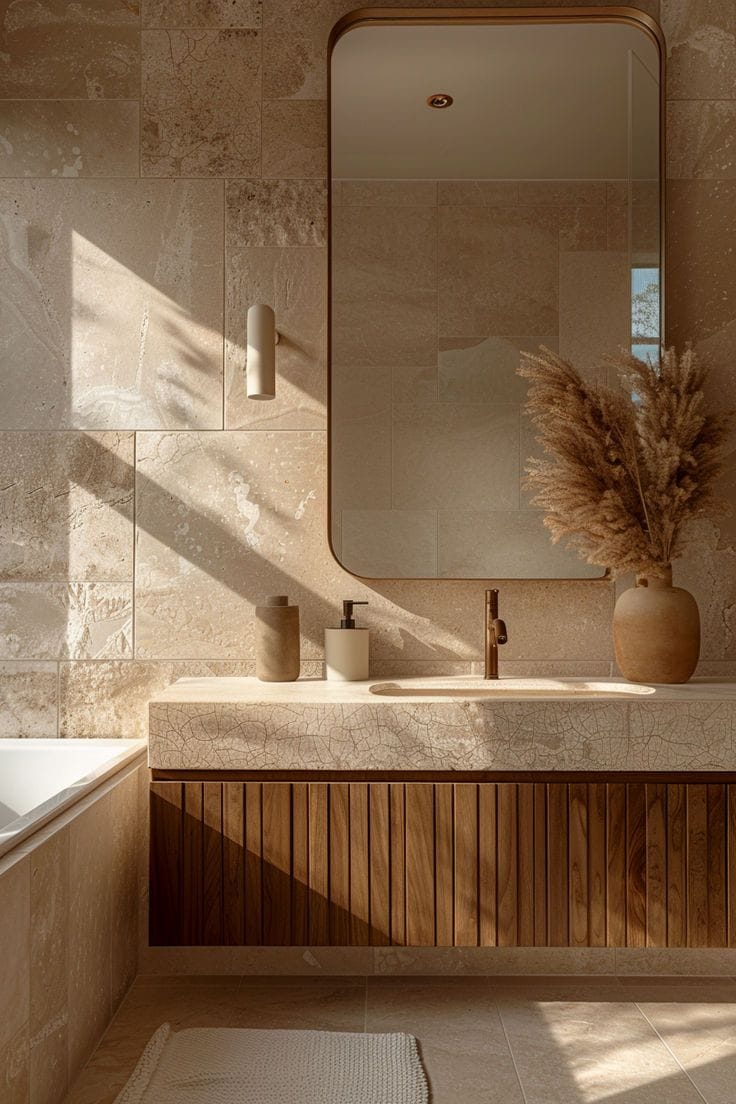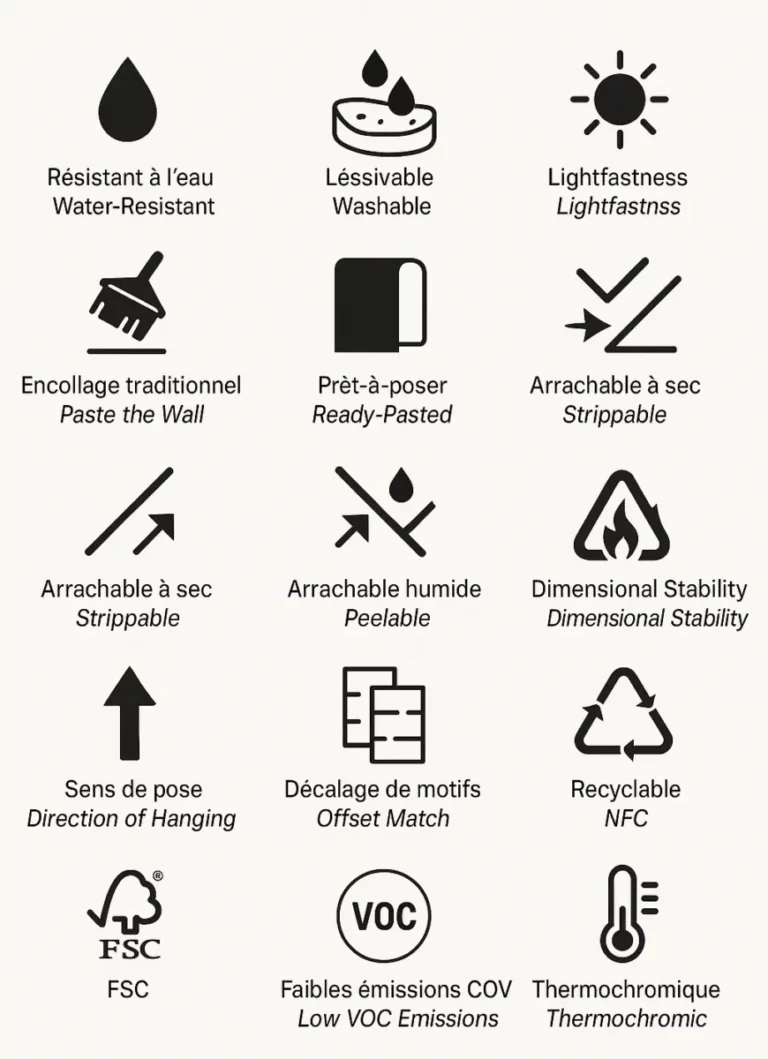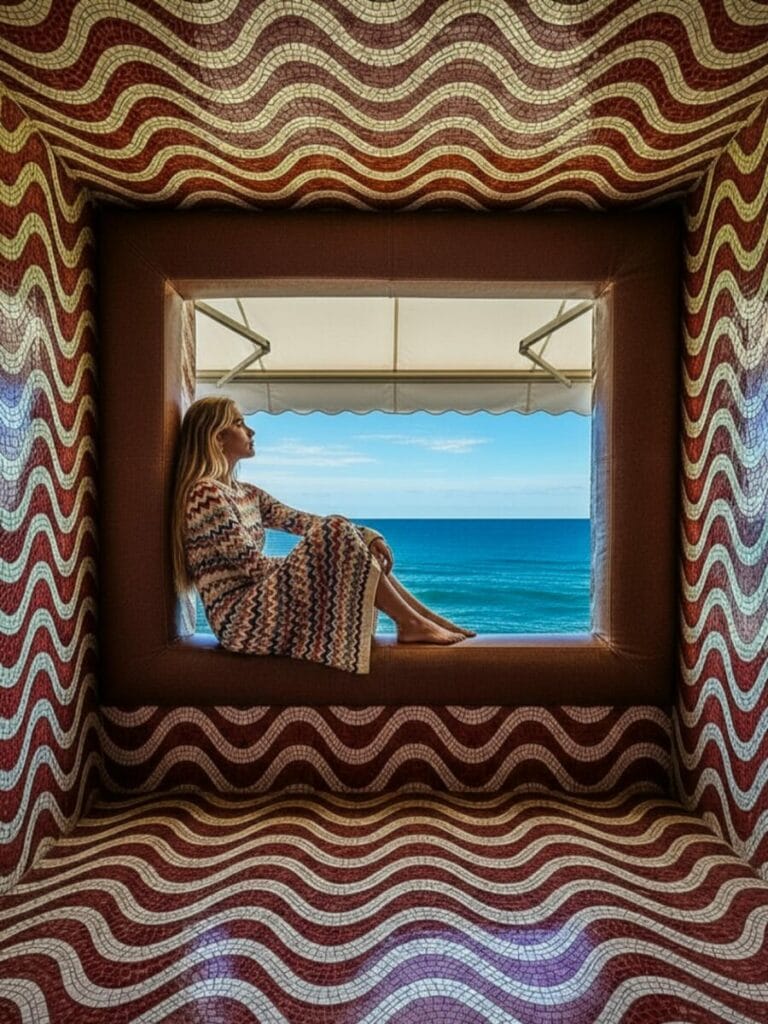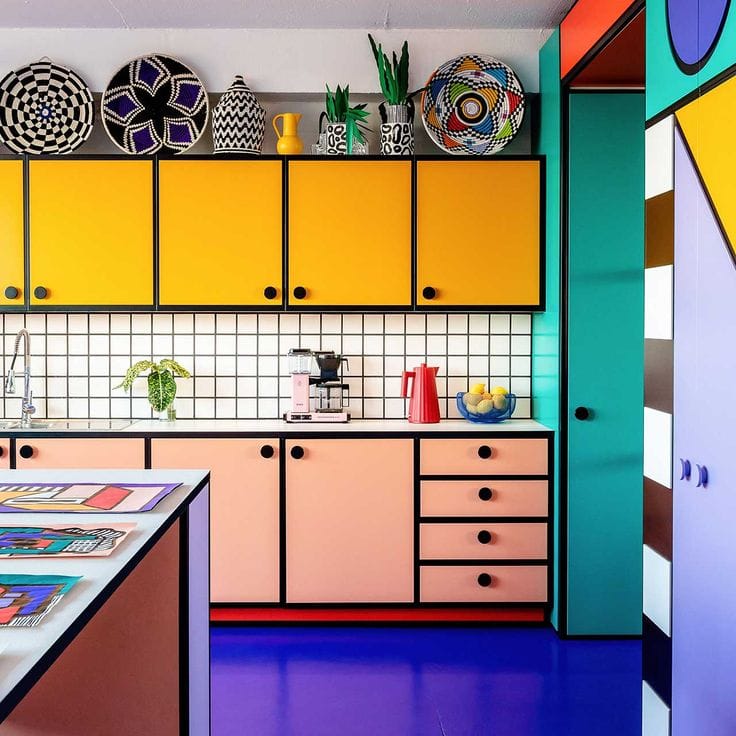Do you know the Empire style?
Do you know the Empire style? This French decorative style is historically situated after the Directoire style and before the Restauration style. It corresponds to the reign of Napoleon Bonaparte (Napoleon I) and marks the peak of French decorative art in the early 19th century. It should not be confused with the Second Empire or Napoleon III style which would follow fifty years later.
The Empire Style: Grandeur and Refinement under Napoleon Bonaparte
The reign of Napoleon I marks a revolution in French decorative art. After the revolutionary troubles, the Empire restores grandeur and imposes an official style of remarkable coherence.
First Empire: An Era of Grandeur
This period, marked by fifteen years of conquest and military glory, ends dramatically with the defeat at Waterloo and the Emperor’s exile to Saint Helena.
Essential chronology:
• 1804-1814: First Empire politically (10 years)
• 1800-1830: Stylistic influence (30 years)
• International equivalents: English Regency style, German Biedermeier style
Napoleon, Patron and Dictator of Taste
This era is remarkably dominated by imperial will. Napoleon Bonaparte personally controls all aspects of decorative art, transforming style into an instrument of power and propaganda.

Joséphine de Beauharnais, then Marie-Louise of Austria influence the tastes of their time, but it is the Emperor who imposes his grandiose aesthetic vision.
A new Empire aristocracy emerges and appropriates the codes of imperial luxury. For the first time since the Revolution, splendor regains its nobility in a republican then imperial framework.
This restoration of French prestige profoundly transforms decorative arts and lays the foundations for French cultural influence in Europe.
Aesthetic and Political Revolution
It is now official architects and decorators who direct decorative arts, replacing scattered aristocratic tastes with a unified State style.
This era marks the peak of French cabinetmaking and the birth of the modern luxury industry.
The aesthetics of the era celebrate imperial grandeur: ancient symbols adorn furniture and decor, testifying to a desire to connect the French Empire to Roman greatness.

Arts: Triumphant Academicism
David and the Neoclassical School
The official art of the Empire favors heroic neoclassicism. Jacques-Louis David, First Painter of the Emperor, shapes the taste of the era with his grandiose compositions.
Antoine-Jean Gros (David’s student), François Gérard (court portraitist), Pierre-Narcisse Guérin (Delacroix’s master) dominate the official artistic scene.
Jean-Auguste-Dominique Ingres develops a more refined style that will survive the Empire, while Théodore Géricault already announces nascent romanticism.
Monumental Sculpture
Empire sculpture favors monumentality and political allegory.
Antonio Canova (official sculptor of the imperial family), Jean-Antoine Houdon (portrait genius), Pierre Cartellier prepare 19th century sculpted art.
Chalgrin’s Arc de Triomphe, the Vendôme Column of ancient inspiration testify to this aesthetic of public grandeur.
In decorative arts, Pierre-Philippe Thomire revolutionizes the art of bronze with his creations of unequaled quality.
Antoine-Denis Chaudet and Claude Ramey complete this sculpted school that durably influences European art.

Empire Architecture:
Percier and Fontaine: The Architects of the Empire
The Grand Projects (1800-1815): Under the impulse of Napoleon I and his architects Charles Percier and Pierre Fontaine, Paris acquires monuments that still mark its urban landscape.
The Percier-Fontaine duo revolutionizes official French architecture: completion of the Louvre, creation of rue de Rivoli, development of the Tuileries.

The development of prestige spaces (Arc de Triomphe du Carrousel, Paris Stock Exchange) transforms the capital into a showcase of the regime.
The creation of coherent street furniture and the multiplication of public fountains make Paris a modern and prestigious capital.
A Codified Architectural Style
Empire architecture is characterized by geometric rigor and assumed ancient references.
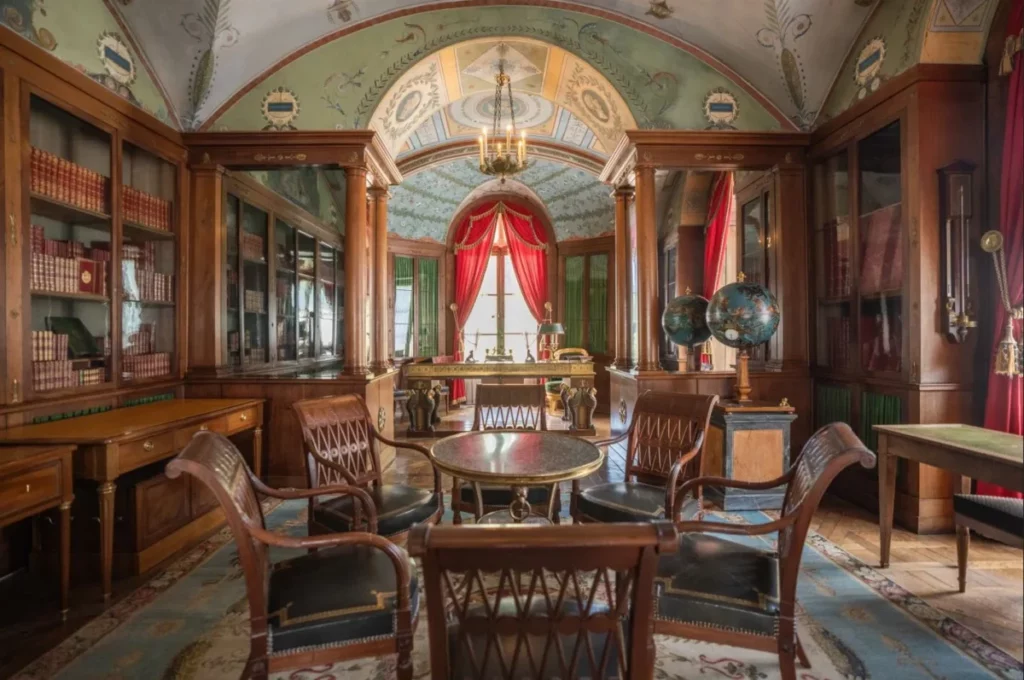
Jacques Gondoin (School of Medicine), Alexandre-Théodore Brongniart (Paris Stock Exchange), Jean Chalgrin (Arc de Triomphe) embody this new monumental aesthetic.
This architectural work, admired throughout Europe, establishes the model for official French architecture for the entire 19th century.
It still conditions today’s international image of Paris and forges the representation of French grandeur.
A New Decor: Total Imperial Art
In the palaces renovated by Percier and Fontaine, the great decorative achievements are marked by stylistic unity, perfect coordination between architecture, furniture and art objects.
Architects Charles Percier and Pierre Fontaine publish their famous “Recueil de décorations intérieures” (1812), true bible of Empire style.
Decorative Innovation
The works of Percier and Fontaine codify a decorative repertoire of exceptional richness: eagles, fasces, laurel wreaths, palmettes.
Dominique-Vivant Denon (director of the Louvre), Alexandre Lenoir (Museum of French Monuments) enrich this vocabulary through their archaeological research.
The influence of the Egyptian Expedition (1798-1801) introduces an archaeological orientalism that profoundly renews French decorative art.
The metal arts experience a golden age with Thomire‘s bronzes, Henri Auguste and Jean-Baptiste-Claude Odiot‘s goldsmithing.
The textile arts regain their excellence with Philippe de Lasalle‘s Lyon silks and Gobelins tapestries directed by Pierre-Adrien Pâris.
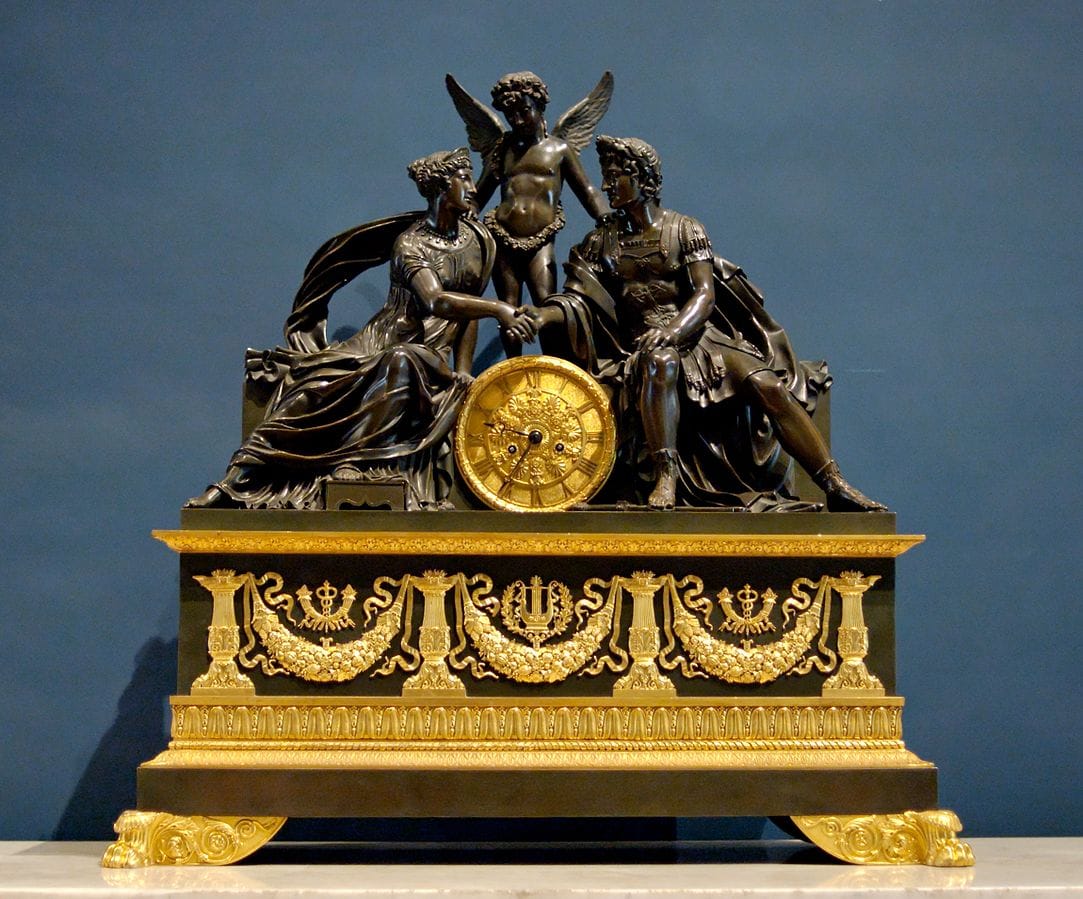
The creations of Martin-Guillaume Biennais (Emperor’s goldsmith), Pierre-Philippe Thomire (bronze worker), and the Jacob brothers (cabinetmakers) democratize an imperial luxury of unequaled quality.
The goldsmithing of Jean-Baptiste-Claude Odiot, the bronzes of Thomire, the silks of Lyon interpret this style according to the imperial taste for grandeur and prestige.
Sumptuous draperies, gilded bronzes, ceremonial furniture characterize this aesthetic of majesty.
Napoleon’s apartments at the Tuileries and Fontainebleau, decorated by Percier and Fontaine, offer the perfect example of this grandiose style where each salon rivals in magnificence.
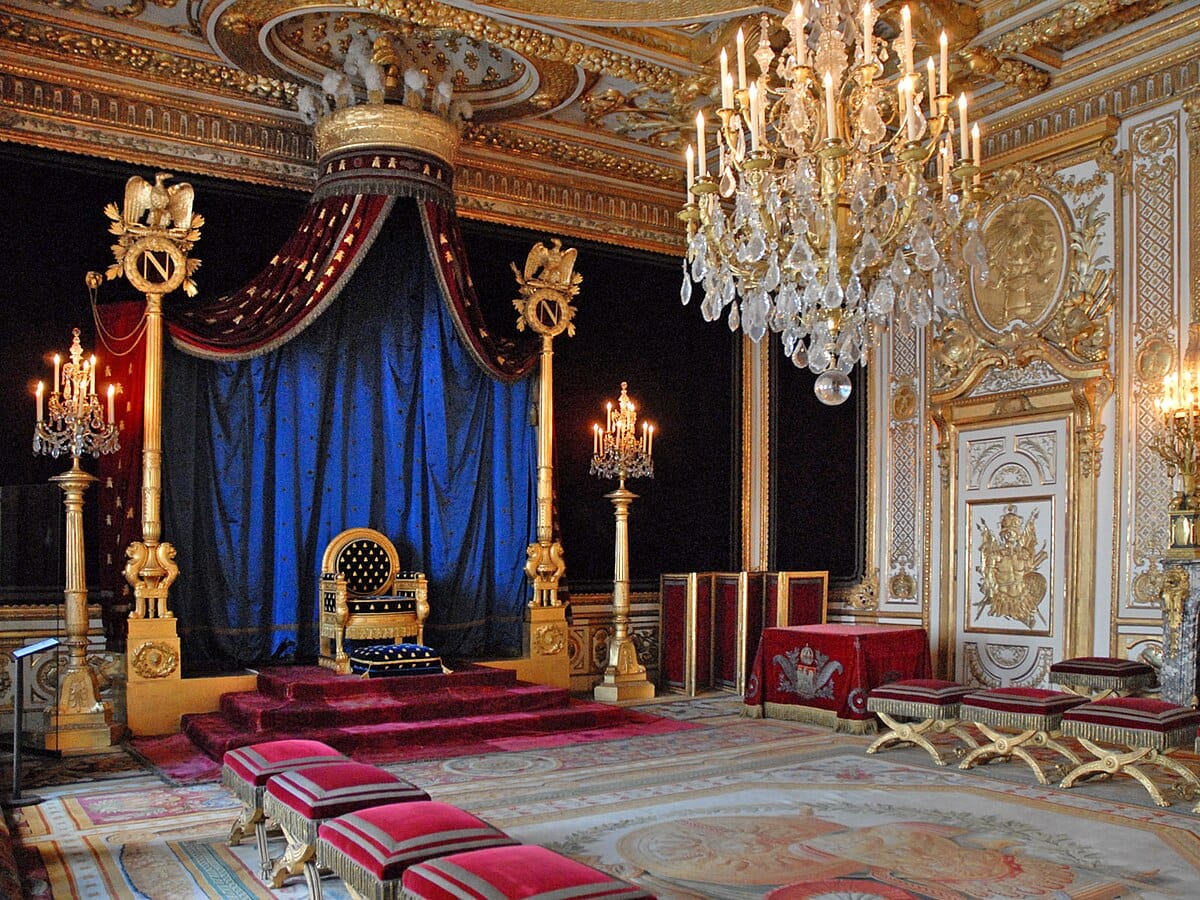
Empire Furniture: Grandeur and Innovation
Major technical innovation: The Empire era perfects marquetry techniques and develops the decorative use of gilded bronze on an unprecedented scale.
This technical mastery allows for finishing of exceptional quality, establishing the worldwide reputation of French cabinetmaking.
Craftsmen favor solid mahogany for its nobility and resistance, often enhanced with mercury-gilded bronzes of remarkable fineness.
The inlay of precious metals, mother-of-pearl and lacquer reaches technical heights under the impulse of the greatest Parisian cabinetmakers.
Decorators innovate with the use of Sèvres porcelain plaques, true paintings integrated into furniture.
Aesthetic revolution: Empire furniture favors pure geometric forms and architectural ornamentation, breaking with 18th century curves.

This new aesthetic revolutionizes the art of furniture and durably influences European and American taste.
The era draws from Greco-Roman Antiquity and Pharaonic Egypt: caryatid-shaped supports, lion claw feet, palmette motifs testify to this learned inspiration.
The Egyptomania born from the Egyptian Expedition seduces with its sphinxes, obelisks and stylized hieroglyphs that renew the French decorative repertoire.
The ingenuity of cabinetmakers creates a typology of furniture of unequaled nobility, responding to the representation needs of the new imperial society.
Among the major characteristics: Empire interiors are distinguished by their majestic organization and perfect stylistic unity.
The rigorous symmetry and use of ceremonial furniture create an aesthetic of official grandeur.
Classification of Empire Furniture: The Art of Cabinetmaking
Seating: New Geometry
Empire furniture revolutionizes traditional forms by favoring geometric rigor and ancient references.
The abandonment of rococo curves in favor of straight lines and sharp angles radically transforms the aesthetic of French seating.
The decorative structure, of unequaled richness, integrates gilded bronzes, inlays and sculptures in a perfectly mastered overall composition.
We find antique-style armchairs with straight backs inspired by Roman curules and gilded bronze ornaments of exceptional fineness.
The gondola armchair simplifies and adopts more geometric lines, losing the sinuous curves of the 18th century.
Curule chairs, directly inspired by Roman magistrate seats, become the emblem of imperial official furniture.
Bergères retain their comfort function but adopt straight backs and armrests sculpted in the form of sphinxes or lions.
Ancient stools with X-shaped legs, often gilded and covered with precious silks, multiply references to Rome and Egypt.
Benches and méridienne are adorned with gilded bronzes and adopt forms inspired by ancient beds, creating resting furniture of sovereign elegance.
The Iconic Creations of the Empire
Iconographic innovation: The Empire invents a coherent decorative repertoire, mixing political symbols and ancient references in a unified aesthetic program.

This iconographic revolution, mixing imperial eagles, fasces and palmettes, reflects the Napoleonic will to create a coherent State art.
Imperial symbols (crowned N, bees, stars) invade all decorative arts, creating a political aesthetic unique in Europe.
Ceremonial furniture multiplies: monumental consoles, precious pedestal tables, secret secretaries testify to the refinement of imperial society.
Empire Tables
The Empire table favors pure geometric forms and architectural ornamentation. The top, often in solid mahogany, rests on a carved base of great decorative nobility.

Consoles and Sideboards
Functional as well as aesthetic innovation, the Empire console adopts monumental proportions and ornamentation of unequaled richness.
In these prestigious creations, mahogany is adorned with mercury-gilded bronzes of exceptional fineness. Entirely sculpted and ornamented, they are adorned with precious marbles with shimmering veins.
They embody the imperial art of entertaining and testify to the refinement of the new Empire aristocracy.
Pedestal Tables: A refined variant of the table, the Empire pedestal table favors the circular form and central sculpted base, often in the form of a column or caryatid.
Like the console, it is furniture with an entirely visible structure, symbol of the exceptional know-how of Parisian cabinetmakers and their decorative mastery.
Secretaries and Desks: Functionality and Prestige
The Empire era develops a range of office furniture of exceptional decorative richness, adapted to the needs of the imperial administration.
Drop-front secretary: Heir to the 18th century but transformed by Empire aesthetics, it adopts straight lines and is adorned with gilded bronzes.
Fluted columns, ancient mascarons and palmettes adorn these pieces of furniture that have become true works of decorative art.
Flat desk: The Empire desk favors monumental dimensions and ceremonial ornamentation, reflecting the prestige of the administrative function.
Gilded bronzes, gilt leathers and precious marquetry testify to the excellence of French cabinetmaking under the Empire.
Remarkable Stylistic Innovations
Antique-style bed: The Empire bed abandons canopies in favor of forms inspired by Greek and Roman beds, often boat-shaped.
The headboard and footboard, of unequal heights, create an elegant silhouette enhanced with gilded bronzes and precious silks.
Clocks and bronzes: The art of bronze reaches an unequaled level of perfection under the Empire, creating art objects that often surpass their utilitarian function.
Thomire‘s clocks, adorned with allegorical figures, sphinxes and Egyptianizing motifs, testify to this technical and aesthetic excellence.
Commodes and Storage Furniture
The Empire commode is distinguished by its pure geometric forms and its architectural ornamentation of majestic sobriety.
The detached columns, often fluted and topped with gilded capitals, punctuate the facade and create an effect of monumentality.
This revolutionary creation evokes ancient grandeur and illustrates the Empire’s ability to create furniture of sovereign nobility.
Psyché and Toilet Furniture
The Empire invents the psyché, large adjustable mirror mounted on a base, revolution in the art of toilet furniture.
These creations, often in mahogany and gilded bronzes, testify to the new attention paid to body care and appearance in imperial society.
Cabinet Secretaries: Refinement and Secrecy
The Empire era develops the art of furniture with secrets with cabinet secretaries of remarkable ingenuity.
These creations, often made for imperial high society, mix functionality and decorative refinement in compositions of fascinating complexity.
The Armoire and Bookcase: Domestic Monumentality
The Empire armoire adopts monumental proportions and architectural treatment, transforming storage furniture into a major decorative element.
Bookcases, adorned with gilded bronzes and bronze grilles, testify to the era’s taste for erudition and the staging of knowledge.
The Jardinière: Nature and Artifice
Decorative innovation of the Empire, the jardinière in gilded bronze or porcelain testifies to the taste for domesticated nature and the art of floral arrangement.
These creations, often mounted on casters, allow for transforming domestic space and testify to the refinement of imperial art de vivre.
Entirely gilded and ornamented, these pieces embody Empire decorative art in its most refined and functional dimension.

Vases and Art Objects: The Excellence of Manufactures
Sèvres vases reach an unequaled level of technical and artistic perfection under the Empire, adorned with paintings of exceptional fineness.
Thomire bronzes, Odiot goldsmithing, Lepaute clocks complete this decorative universe of incomparable richness.
The Masters of Empire Style
The Empire marks the peak of French craftsmanship, a period when technical excellence meets ancient inspiration to create a style of perfect coherence.
This exceptional era sees the birth of a generation of craftsmen who durably define French quality standards worldwide.
The Genius Cabinetmakers
Georges Jacob (1739-1814) and his sons Georges II and François-Honoré-Georges Jacob-Desmalter perfectly embody the excellence of Empire cabinetmaking.
Their workshop, official supplier to Napoleon, creates furniture for the Tuileries, Fontainebleau and Compiègne with unequaled technical mastery.
The Jacob brothers revolutionize the art of seating by developing gilding and sculpture techniques of perfection that influence all of Europe.
Their “Joséphine’s Bed” at Malmaison and the seats of the Grand Trianon testify to their creative genius and their ability to translate imperial aesthetic ambitions.
Pierre-Antoine Bellangé (1757-1827) completes this triumvirate with his creations of sovereign elegance for imperial residences.
His commodes and secretaries, adorned with Thomire bronzes, establish the canons of French prestige furniture.
The Art of Bronze: Thomire and his Followers
Pierre-Philippe Thomire (1751-1843) revolutionizes the art of decorative bronze and brings this craft to a level of perfection never equaled.
Trained with Houdon, he develops a technique of chiseling and mercury gilding of exceptional fineness that makes his creations true sculptures.
His collaborations with cabinetmakers Jacob and Weisweiler, his allegorical clocks and his lighting transform bronze into major art.
The Thomire workshop, employing more than 800 workers, becomes the world reference for precious metal arts and durably influences European goldsmithing.
André-Antoine Ravrio (1759-1814) and Claude Galle (1759-1815) complete this Empire bronze school with their creations of remarkable technical quality.
Prestige Goldsmithing
Beyond the famous Odiot, a constellation of exceptional goldsmiths animates the Parisian workshops of the Empire.
Jean-Baptiste-Claude Odiot (1763-1850), Emperor’s goldsmith, creates the imperial verm

Digital entrepreneur and craft artisan, I use my unconventional background to share my vision of luxury design and interior decoration — one enriched by craftsmanship, history, and contemporary creation. Since 2012, I have been working daily in my workshop on the shores of Lake Annecy, creating bespoke interiors for discerning decorators and private clients.


